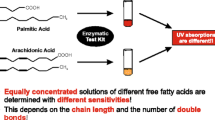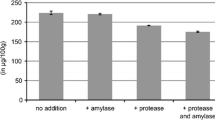Abstract
The folic acid content of food of animal origin was determined by means of high-performance liquid chromatography (HPLC). Free folate (monoglutamate forms) and total folate (monoglutamate + polyglutamate forms) were differentiated. Liver (bovine 963, hog 136 μg/100 g) and kidney (bovine 410, hog 93 μg/100 g) contained the highest content of total folate, followed by egg (67μg/100g), soft cheese (44-62μg/100 g), milk and other dairy products (3-28 μg/100 g). Chicken, fish, beef and pork contained only a low content of total folate (1-12 μg/100 g). The free folate portion ranged from 14.7 to 100% (mean 69.2%). The main folate derivatives tetrahydrofolic acid (THF), 5-methyl-THF and 5-formyl-THF showed the following distribution. In milk and milk products the mean was 70% for 5-formyl-THF, 20% for 5-methyl-THF and 10% for THF; in the other products the three derivatives were distributed about equally but the range of variation was high.
Zusammenfassung
Von Lebensmitteln tierischer Herkunft wurde mit Hilfe der Hochleistungsflüssigchromatographie (HPLC) der Folsäuregehalt bestimmt. Es wird unterschieden zwischen freiem Folat (Monoglutamaten) und Gesamtfolat (Monoglutamate + Polyglutamate). Leber (Rinder- mit 963, Schweineleber mit 136 μg/100 g) und Nieren (Rinder- mit 410, Schweinenieren mit 93 μg/ 100 g) enthielten die höchsten Gesamtfolatgehalte, gefolgt vom Hühnerei (67 μg/100 g), Weichkäse (44-62 μg/ 100 g), Milch und anderen Milchprodukten (3-28 μg/ 100 g). Brathähnchen, Fisch, Rind- und Schweinefleisch enthielten dagegen nur niedrige Gesamtfolatgehalte (1-12 μg/100 g). Der Anteil freien Folats am Gesamtfolatgehalt reichte von 14,7% bis 100% (Mittelwert 69,2%). Die wichtigsten Folsäure-Derivate Tetrahydrofolsäure (THF), 5-Methyl-THF und 5-Formyl-THF waren wie folgt verteilt: In der Milch und den Milchprodukten war im Mittel die 5-Formyl-THF zu 70%, die 5-Methyl-THF zu 20% und die THF zu 10% vertreten, in den anderen Produkten zu ungefähr jeweils einem Drittel mit jedoch hoher Schwankungsbreite.
Similar content being viewed by others
Literatur
Müller H (1993) Z Lebensm Unters Forsch 196:137–141
Gregory III JF, Sartain DB, Day BPF (1984) J Nutr 114:341–353
Hages M, Mirgel C, Pietrzik K (1987) Vitam Mineral Spur 2:155–169
Souci SW, Fachmann W, Kraut H (1989/90) Die Zusammensetzung der Lebensmittel-Nährwert-Tabellen. Wissenschaftl Verlagsgesellschaft, Stuttgart
Ernährungsbericht (1988) Deutsche Gesellschaft für Ernährung, Frankfurt/M
Engelhardt R, Gregory III JF (1990) J Agric Food Chem 38:153–158
Perloff BP, Butrum RR (1977) J Am Diet Assoc 70:161–171
Aramouni FM, Godber JS (1991) J Food Quality 14:357–365
Tamura T, Stokstad ELR (1973) Brit J Haematol 25:513–532
Holt DL, Wehling RL, Zeece MG (1988) J Chromatogr 449:271–279
Yamada M (1979) Vitamins 53:221–227
Hawkes JG, Villota R (1989) Crit Rev Food Sci Nutr 28:439–538
Rao DR, Reddy AV, Pulusani SR, Cornwell PE (1984) J Dairy Sci 67:1169–1174
Drewek Z, Czarnocka-Roczniakowa B (1986) Acta Aliment Polonica 12:39; FSTA 19:164, 5P190 (1987)
Wachol-Drewek Z, Roczniak B, Grabowska E (1986) Przem Spozyw 40:216; FSTA 20:134, 2P73 (1988)
Deutsche Gesellschaft für Ernährung (1991) Empfehlungen für die Nährstoffzufuhr. 5. überarbeitung. Umschau, Frankfurt/M
Author information
Authors and Affiliations
Rights and permissions
About this article
Cite this article
Müller, H. Die Bestimmung der Folsäure-Gehalte von Lebensmitteln tierischer Herkunft mit Hilfe der Hochleistungsflüssigchromatographie (HPLC). Z Lebensm Unters Forch 196, 518–521 (1993). https://doi.org/10.1007/BF01201330
Received:
Issue Date:
DOI: https://doi.org/10.1007/BF01201330




